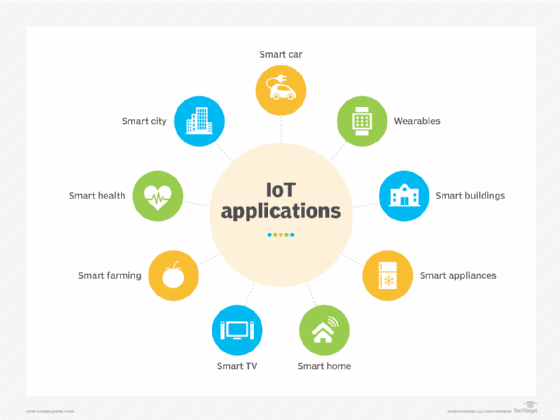
Elnur - stock.adobe.com
Take lessons from the best 5 IoT blogs of 2020
IT administrators can catch up on the most popular topics of 2020 with IoT blogs on remote security, healthcare IoT and open source analytics platforms.
In 2020, the IoT industry shifted its focus to adapt during the COVID-19 pandemic, where the top priorities were to keep people safe and healthy and to find better protocols through technology.
Despite the difficulties that organizations faced, the pandemic forced IoT innovations and accelerated the development of new use cases. Organizations applied IoT technology to better track the movement of people, vehicles and goods and implemented networking and AI.
Explore the topics IT admins were most interested in learning about IoT in 2020 with the top five IoT blogs and see where IoT can take organizations over the next few years.
1. COVID-19 makes healthcare IoT use cases focal point of 2020
Although Intelligent Product Solutions' Mitch Maiman wrote "IoT technology for healthcare in 2020" during the early days of the COVID-19 pandemic, the points he made about health monitoring and destroying pathogens only became more relevant. Patient monitoring with IoT sensors has the capability to improve patient care quality and reduce healthcare costs. Healthcare providers can use robotics to assist with routine processes, such as patient monitoring or consumables transport.
When combined with IoT, AI can provide greater insight to healthcare use cases. Organizations can aggregate IoT data from disparate sources and apply an AI model to the data to predict machine failures and health threats before they wreak havoc. Healthcare facilities require rigorous cleaning to prevent the spread of infections, but emerging technologies, such as high-powered UV LED lights can destroy pathogens on surfaces. IoT sensors can track the use of these emerging technologies to ensure their effectiveness or even detect pathogens themselves to stop the spread of infection.

2. IoT opportunities grow under COVID-19 stress
The COVID-19 pandemic showed many organizations how they can use IoT devices to improve services and protect customers and workers. In "How can IoT help in the COVID-19 crisis," Maiman explored the ways healthcare facilities could use medical IoT devices to better prevent and manage the spread of a future outbreak.
Through remote monitoring sensors and improved telemedicine, healthcare providers can minimize the number of healthcare workers who must be in contact with an infected patient, while still maintaining patient care. Across the healthcare industry, IoT sensors can track the movement of both equipment and people, and RFID-tagged products can manage supply surpluses and deficits more effectively. Healthcare providers can also use the technology to perform contact tracing and keep track of individuals who have come into contact with COVID-19.
3. Increase in remote work prioritizes security
After a large portion of the working population shifted to a work-from-home setup, personal IoT devices and unsupervised workplace devices became more urgent for admins to address potential IT security issues.
Many employees use personal laptops or desktops to work from home, as well as banking, shopping, e-learning or entertainment. This means devices that access work files share the same network as smart home devices, which expand the potential attack surface for hackers. Any device vulnerability on the home network puts all other devices at risk, including those that connect to a work network.
In empty offices and operations with skeleton crews, smart building technology continues to run when no one is there, such as environmental controls and security cameras. Compromised SCADA systems and industrial IoT sensors can more easily go unnoticed.
In "With everyone working from home, who's minding the security?" Jonathan Nguyen-Duy of Fortinet discussed an action plan to address security at home and the corporate office. A modified IoT security strategy must focus on remote security measures, including keeping workers educated on security hygiene; proper use of secure remote connections, such as a VPN; and endpoint detection and recovery. Organizations might consider adding network segmentation; AI to identify new threats; and network access controls to discover, identify and add any device onto work networks.

4. Open source platforms become essential to process IoT data
GridGain Systems' Nikita Ivanov explained the role of IoT analytics in "Build a data streaming AI and machine learning platform for IoT." With the massive amount of IoT-generated data, organizations must turn to machine learning algorithms for real-time data processing. Use cases, such as patient monitoring, autonomous vehicles or predictive maintenance depend on instantaneous actions to keep people safe.
Organizations can rely on a variety of open source products to address challenges of IoT deployment without significant upfront costs. Admins can use Apache Kafka or Apache Flink to create real-time data pipelines and Apache Ignite for distributed in-memory computing. Kubernetes simplifies the process to deploy and manage container applications. Distributed computing engines, such as Apache Spark, aggregate and analyze IoT data.
5. Network advancements broaden IoT use cases
5G private networks can help organizations use IoT in remote and isolated locations where data must transmit without a large investment in connectivity infrastructure. The technology also brings new capabilities -- including customizable rules for network traffic priorities, built-in security and low latency -- that enable 5G to replace other private networks in specific use cases. For example, augmented reality products require the low latency that 5G offers.
In "5G private networks to help expand IoT," Deloitte Consulting's Helena Lisachuk explained situations where private 5G networks offer advantages over other network types, such as transportation ports, factory robotics and temporary work in remote areas. The use of temporary work sites and private 5G networks lets organizations avoid the need to set up network infrastructure that is only required for a short period of time.






